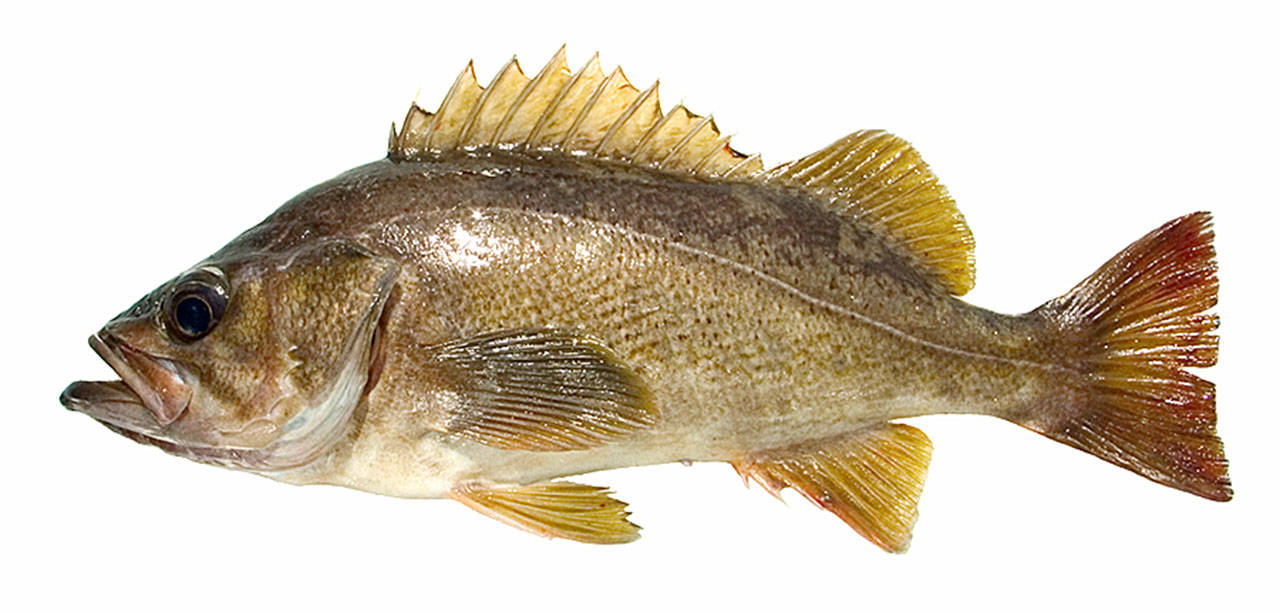INCREASED FISHING OPPORTUNITIES are about as rare as a playoff appearance for the Seattle Mariners.
But going forward this spring, recreational anglers will have more time and more and deeper water upon which to fish for lingcod, rockfish and other groundfish off the coast of Washington.
Coastal groundfish anglers are in for a relaxation of some restrictions as part of the National Oceanic and Atmospheric Administration’s move to boost catch limits by more than 100 percent for some species of rockfish.
The move is expected to be a boon for West Coast commercial trawlers and sportfishing outfits, and comes about after rockfish populations rebounded over the previous decade and a half — partly due to some low estimates of rockfish productivity based on poor oceanic conditions in the 1990s and some strict fisheries management decisions put in place to prevent rockfish extinction as a result.
“It’s exciting. It’s some really positive news,” said Tom Burlingame, owner of Excel Fishing Charters (360-374-2225) and a comittee member of NOAA’s Pacific Fisheries Management Council’s Groundfish Advisory Subpanel.
Lings in deeper water
Burlingame is particulary enthused about the move of a 20-fathom depth restriction intended to protect yelloweye rockfish, which suffer from greater mortality when fished in waters greater than 20 fathoms, from early May to June 1.
“This year we will get to fish for lingcod and rockfish in that deeper water for an additional month,” Burlingame said. “A lot of people really enjoy that lingcod fishing, so this is one of the biggest positives we’ve seen.”
Heather Reed, coastal policy coordinator for the state Department of Fish and Wildlife said the new rules will allow anglers to deep water fish for lings and rockfish while also allowing the department to gain a deeper insight in fishing conducted in these newly re-opened depths.
“There was a lot of interest in providing new opportunity, but in taking a conservative approach in how we did that,” Reed said.
“Its been a long time since fishing was conducted in these deep water areas and we didn’t want to negatively impact yelloweye rockfish. Fishing in these deeper water areas will give us a good idea of yelloweye encounters in areas we haven’t had data.”
A boost for combo trips
Additionally, this rule change allows retention of yellowtail and widow rockfish, known as midwater rockfish, in waters deeper than 20 fathoms during summer recreational salmon seasons in July and August in Marine Areas 3 and 4.
Burlingame said this will prevent unintended yellowtail mortality while also limiting the pressure on black rockfish.
“We will be able to keep yellowtail and widow rockfish while out there salmon fishing,” Burlingame said. “Nice change for us. We do combo trips during salmon season and go out to Blue Dot and catch kings, and we catch a lot of yellowtail on downriggers that we have to return.
“Then we would go back to shore to for rockfish.
“We’ve been releasing those yellowtail caught in the deep water, those fish have a mortality rate, so this way we can lessen mortality rates from released fish, while still catching a lot of those yellowtail and take pressure off those black rockfish closer to shore.”
Reed is happy to see the change.
“Turning that bycatch into retained fish is a positive all the way around,” Reed said.
Anglers also will be able to keep more canary rockfish, after that species’ sublimit was removed along the entire Washington coast.
Previously, anglers could keep up to two canary rockfish as part of the seven rockfish daily limit.
“I know we have been on a smaller bag limit for canaries, but there’s enough of them that if you happen to get over some canaries you can keep up to seven,” Burlingame said.
“When you catch a nice canary, it’s kind of nice to throw them in the box.”
Reed said canary rockfish were declared rebuilt in 2015.
“We took input from stakeholders and allowed retention of canary on a reserved one to two fish bag limit before, primarily to see if folks were misidentifying yelloweye and canary rockfish and that wasn’t occuring.”
There is one limit that will be lowered next spring. Anglers will have a one cabezon daily limit in Marine Area 3 going forward. Previously, the limit was two cabezon for Marine Area 3. This change now alignslimits for all four coastal marine areas.
And Burlingame said there’s another impact resulting from NOAA’s annoucement of a rockfish resurgence.
“One of the big things on this for recreational anglers is we are starting to see the benefits of using descending devices,” Burlingame said referring to devices that
These descending devices, which range from a simple inverted barbless hook to a pressure-activated clamp that opens automatically at depth, give anglers the ability to return weak or buoyant rockfish to deeper waters, reversing many of the signs of barotrauma — a pressure-related injury caused by gas in an expanded swim bladder when fish are brought to the surface — and increasing the likelihood of that fish’s survival.
“It really cements how important it is to use those devices,” Burlingame said.
“It’s nice to do the right thing, to be able to descend those fish and not see them floating away. To be able to reap the reward like that.
And there’s likely to be a financial reward in increased angler trips and charter outings.
“It’s difficult to project ecnomic impact, but these changes should increase angler trips,” Reed said. “We’ve heard from anglers interested in deep-water fishing, especially for lingcod, for years. I know coastal communities are encouraged by this and we believe it will provide benefits all along the coast.”
Burlingame agreed.
“Bottomfishing has been a bright spot for us with decreasing salmon runs and less time on water, especially here on the North Coast,” Burlingame said.
“It’s nice to get this good news.”
________
Sports reporter/columnist Michael Carman can be contacted at 360-417-3525 or mcarman@peninsuladailynews.com.

